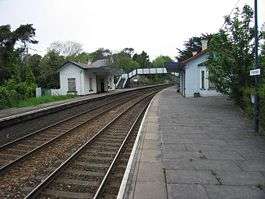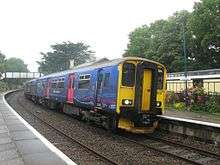St Germans railway station
St Germans railway station serves the village of St Germans in Cornwall, England. The station is managed by Great Western Railway and is situated on the Cornish Main Line 10 miles 33 chains (16.8 km) from the line's northern terminus of Plymouth[1] and 255 miles 10 chains (410.6 km) from London Paddington via Bristol Temple Meads. The station is situated just west of the St Germans Viaduct.
| St Germans | |
|---|---|
 | |
| Location | |
| Place | St Germans |
| Local authority | Cornwall |
| Coordinates | 50.394°N 4.309°W |
| Grid reference | SX360574 |
| Operations | |
| Station code | SGM |
| Managed by | Great Western Railway |
| Number of platforms | 2 |
| DfT category | F2 |
| Live arrivals/departures, station information and onward connections from National Rail Enquiries | |
| Annual rail passenger usage* | |
| 2014/15 | |
| 2015/16 | |
| 2016/17 | |
| 2017/18 | |
| 2018/19 | |
| History | |
| Original company | Cornwall Railway |
| Pre-grouping | Great Western Railway |
| Post-grouping | Great Western Railway |
| Opened | 1859 |
| National Rail – UK railway stations | |
| |
Description
Both platforms have step-free entrances (though the footbridge linking them has steps) and basic facilities - waiting shelters, bike racks and bench seats on each side. The platform nearest St Germans Quay is served by trains to Liskeard (and ultimately Penzance). The other platform is used for trains towards Plymouth. Running information is provided by timetable posters and a public telephone. No ticket machine is available, so passengers must buy tickets prior to travel or on the train.[2]
To the east of the station, the thirteen arch stone viaduct of 1908 (which replaced the original timber one built in 1859) takes the railway over the River Tiddy.[3]
History
The station opened with the Cornwall Railway on 4 May 1859. It was described at the time as "of ornamental design ... conveniently situated close to the town, and consists of arrival, departure, and goods stations, all three being constructed of stone".[4]
A fatal accident occurred near St Germans just two days after the opening of the railway. On 6 May 1859, the 7.25 p.m. train from Plymouth was approaching St Germans when the engine left the rails, hit the parapet of the wooden viaduct across Grove Creek and fell 38 feet into the mud below, landing upside down; two of the coaches also ended up in the creek. The driver, fireman, and one of the guards were killed. A second guard, Richard Paddon, was given a reward of five pounds (equivalent to £505 in 2019)[5] for his part in keeping the remainder of the train on the viaduct and helping to rescue the survivors.[6]
The Cornwall Railway was amalgamated into the Great Western Railway on 1 July 1889. On 1 January 1948, the Great Western Railway was nationalised, amalgamating with other railways to form British Railways, which was privatised in the 1990s.
In 1973, a signal panel was located in the old station buildings on the platform served by trains to Penzance, although this has since closed. The other building is private accommodation but a camping coach in the old sidings can be rented for holidays.
Services

St Germans is served by about half the trains on the Cornish Main Line between Penzance and Plymouth - these are mostly local stopping trains, but a few run through to/from London Paddington station.[7] Sunday trains also call here, but on an irregular frequency with sizeable gaps at certain times of day.
| Preceding station | Following station | |||
|---|---|---|---|---|
| Saltash | Great Western Railway Cornish Main Line |
Menheniot | ||
References

- "Western Route Sectional Appendix Module WR1" (PDF). Network Rail. 5 March 2016. Retrieved 6 March 2016.
Plymouth 245 [miles] 75 [chains] St Germans 256 [miles] 28 [chains]
- St Germans station facilities National Rail Enquiries
- Beacham, Peter; Pevsner, Nikolaus (2014). The Buildings of England. Cornwall. Yale University Press. p. 550. ISBN 9780300126686.
- West Briton and Cornwall Advertiser, Railway Special Edition, 1859
- UK Retail Price Index inflation figures are based on data from Clark, Gregory (2017). "The Annual RPI and Average Earnings for Britain, 1209 to Present (New Series)". MeasuringWorth. Retrieved 2 February 2020.
- MacDermot, E T (1931). History of the Great Western Railway, volume II 1863-1921. London: Great Western Railway.
- Table 135 National Rail timetable, May 2017